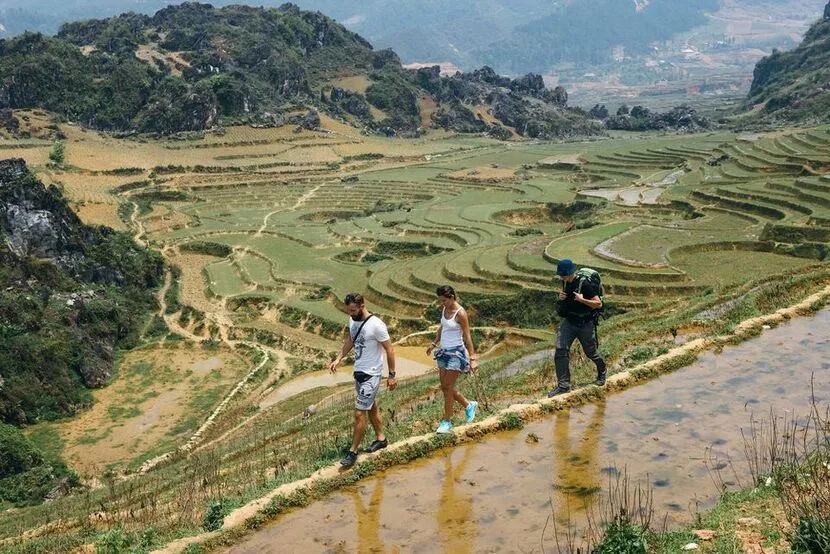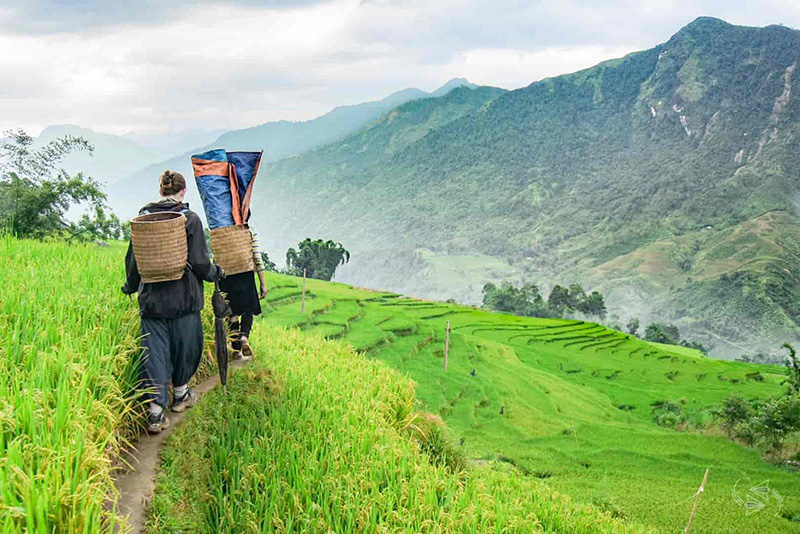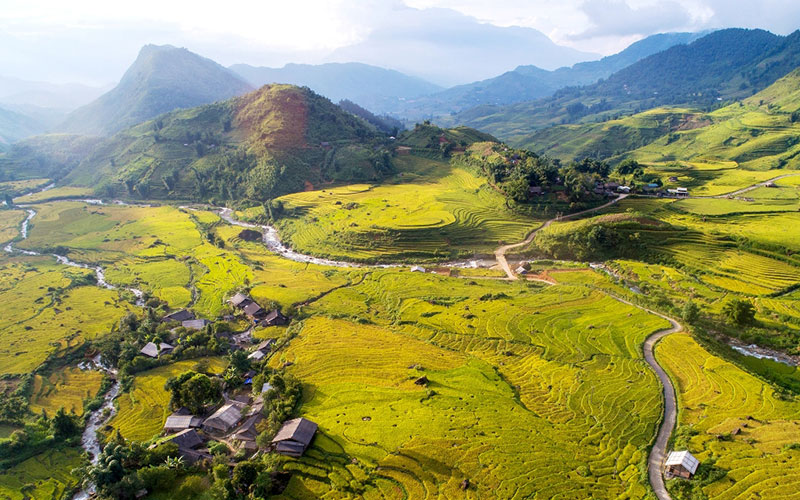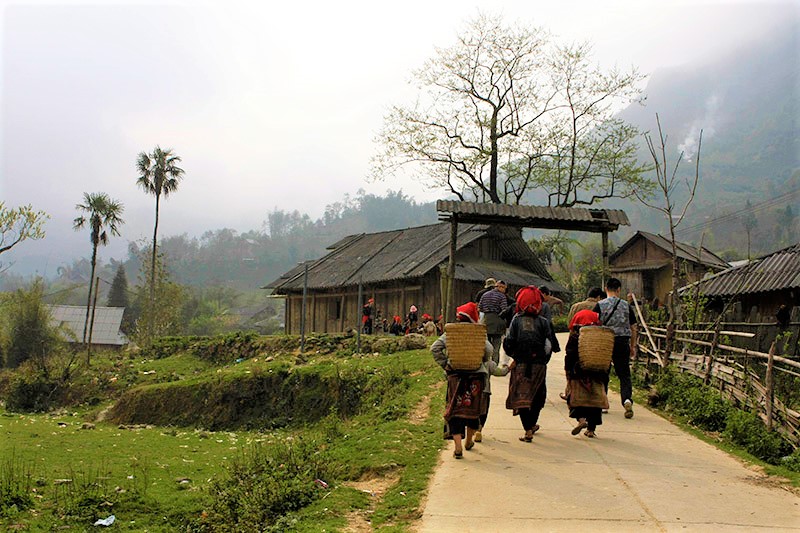As well as superb rice terraces, spectacular mountain views, colourful hill tribe markets and the famous Mount Fansipan – ‘the roof of Indochina’, Sapa is one of the most beautiful trekking sites in northern Vietnam with a dense network of mountain trails. Hiking through ethnic minority villages, past rice terraces and rolling mountains, gives you the chance to get a glimpse of local cultures and immerse yourself in natural beauty.
With so many different trekking routes in Sapa, ranging from easy to challenging, you may be confused as to which one is best for you. So, this article from a Sapa trekking guide is a good source for you to get more detailed information and prepare well for your upcoming trip.

1. How long does a trekking tour in Sapa last?
A full-day trek in Sapa is enough to explore the most important places for those who don’t have much time. But if you don’t want to miss out on the opportunity to fully experience the local way of life and relax in the natural beauty, spending 2-3 days will be perfect.
For longer treks, tourists choose to stay with local people in ethnic villages. This is an excellent opportunity to get close to the locals, interact with them and gain a better understanding of their daily lives.
2. When is the best time to trekking in Sapa?
The weather is one of the most important factors that can make or break your trekking experience. Clouds can obstruct your view and mud makes it difficult and sometimes unpleasant to climb a steep slope.
The ideal time to trekking in Sapa is therefore from March to May and from September to November. You can also trek in summer or winter, but it’s not really perfect.
– March – May (spring): The weather is dry and sunny with moderate temperatures during this period, creating a good condition for trekking. It’s also the time when plants and flowers start to bloom. This is also the time of year when local ethnic minorities plant rice.

– September – November (autumn): This is autumn in Sapa and the weather is relatively good and dry. You’ll have the chance to enjoy the golden rice terraces, which are the most photogenic with their beautiful shades of green and gold. However, this is the high season in Sapa, so there will be more people around.
– June – August (summer): It’s summer but also the rainy season in Sapa. You can certainly do a trek during this period where you’ll find lush green countryside. Heavy showers can sometimes affect your trip, but it doesn’t rain all day. There is always sunny weather in between.
– December – February (winter): It gets quite cold in Sapa during the winter, with temperatures ranging from 8 to 15°C, and even as low as 0°C. You may be lucky enough to see snow on the high peaks.
3. Trekking levels in Sapa
Sapa offers 3 levels of trekking to suit all travellers:
– Easy Trekking: An easy trekking route will normally take you to ethnic villages close to Sapa town, giving you a brief understanding of the local culture. For those pressed for time or unfamiliar with trekking, this is a wise choice. You can spend half a day to a full day for easy trekking.
– Medium trekking: The medium trekking route in Sapa is quite similar to the easy trekking, but takes longer. It will take you to paths off the beaten track that are not easily accessible by car or motorbike.
– Difficult trekking: The most difficult trek is absolutely the trek to the summit of Fansipan Peak. It is only recommended for experienced trekkers as it requires specific skills and good physical health. For easy to medium treks, you can go it alone without a guide. For difficult treks, however, you need to be accompanied by a local guide or porter, who knows the area inside out to avoid getting lost. Normally, you will need 3 days to complete the trek, but this depends on the route you take.
4. Best trekking routes in Sapa
4.1. Lao Chai and Ta Van villages
- Length of excursion: 1 day
- Trekking level: Easy – Medium
- Distance: 6-8 km
This trek offers spectacular scenery of cloud-shrouded mountains and the chance to pass through traditional hill tribe villages and their surrounding rice fields. The trek first follows a small track, crosses the Muong Hoa River and passes through the well-tended rice terraces and stately homes of the villages of Lao Chai and Ta Van. You’ll learn how rice is grown and the lives of ethnic minorities such as the Black Hmong, Zay and Red Dao.
4.2. Villages of Cat Cat – Sin Chai
- Length of excursion: Half a day
- Trekking level: Easy
- Distance covered: 3-5 km
This trekking trail is more of a walk than a hike. Cat Cat is an old village of the Black H’mong people, famous for its brocade weaving and gold and silver jewellery. The walk to the village and its neighbouring hills allows you to see the farms and techniques used by the local people.
Climbing up the mountain, you will reach Sin Chai, a village of the Red Dao people, which offers many magnificent landscapes. As they pass through the village, tourists are usually accompanied by local children. They may not be highly educated, but they are extremely hospitable and enthusiastic. On top of that, you’ll also have the chance to enjoy flowers such as peach trees, plum trees, gladioli, pear trees, roses… if you come here in spring.
4.3. Can Ho B – Ta Giang Phinh village
- Length of stay: 1 day
- Trekking level: Easy – Medium
- Distance: 5-7 km
Located around 25 km from the town of Sapa, the village of Can Ho B (Can Hồ B)- Ta Giang Phinh is a beautiful, unspoilt place. After an hour’s drive along the wilderness of thick rainforest on high mountains, dotted with rolling valleys and local villages, you’ll reach the land of Ta Giang Phinh.

Your trek often begins at Can Ho B, home to the Red Dao people, then continues to Ta Giang Phinh, a blue H’mong village. This village is not yet influenced by mass tourism, so the local houses and lifestyles remain authentic. During the trek, you are warmly invited to visit any of the local houses to get a better insight into local cultures and learn how traditional costumes are made from hemp and dyed by the indigo plant. The people here are very friendly and love to share their lives. What’s more, the scenery of large rice terraces and peaceful streams is beautiful and perfect for photos.
4.4. Villages of Sa Seng – Hang Da – Hau Thao
- Excursion duration: 1 day
- Trekking level: Medium – Difficult
- Distance: 12-15 km
Sa Seng, Hang Da and Hau Thao are the villages of the Hmong tribe in Sapa. They are located around 10 km from Sapa town and are less visited and unspoilt. This trek to the village of Hang Da, at an altitude of 1,800 m, offers magnificent views over the Muong Hoa valley. On the way, you’ll pass through a number of ethnic villages and can visit local houses to understand their way of life and enjoy the scenery, not forgetting to take the best photos.
4.5. Ta Phin village
- Duration: Half to full day
- Trekking level: Easy – Medium
- Distance : 5-7 km
Ta Phin village is located around 12 km from the town of Sapa. This village of Red Dao and Hmong people has a rich culture that has not been damaged by modern life. The Red Dao are renowned for their expertise in herbal medicine and for using plants from the earth to treat many illnesses.

Walking through the surrounding countryside, you will enjoy the picturesque scenery of spectacular rice fields, mountains, streams and hill tribe houses. It’s great to spend a few hours wandering around the village, exploring local life and interacting with them.
5. What do I need to bring for the trek in Sapa?
For your trek, you should keep your bag as light as possible:
– Food and water: Make sure you have enough food and water during your trek as there won’t be many shops along the way. Certain foods should be taken along, such as bread, snacks, sausages, canned food…. and water.
– A light jacket: Whatever time of year you go trekking in Sapa, you’ll need a warm jacket. The nights can be chilly even in the hottest months. If you’re going to Sapa in the colder months, you’ll need several layers to keep warm, and it will be easier to adapt to the temperature as it changes during the day.
– Trekking shoes: A good, comfortable pair of trekking shoes is absolutely essential. You’ll be walking up muddy hills, crossing slippery rocks in streams and there are lots of steep ascents and descents.
– Sun cream/hat/sunglasses: These will be good friends when trekking in summer.
– Camera: You’ll need this to take photos of the beautiful scenery.
– Mosquito repellent/spray
